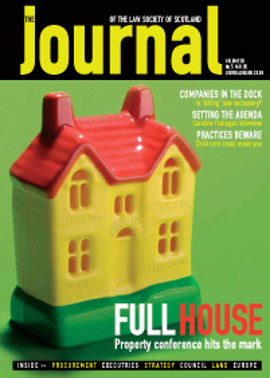Unintended effects?

In 2003, 55% of the 10,928 divorces in Scotland proceeded on the ground of two years’ non-cohabitation with consent, and 27% on five years’ non-cohabitation. Only 18% proceeded on grounds of fault, according to the Registrar General’s Annual Review of Demographic Trends. The Scottish Executive’s stated intention is to enable couples to end their marriage without conflict and recrimination, separating their feelings towards each other from the issues affecting property and children. With the current Family Law (Scotland) Bill, the Executive seeks to shorten the period of separation required from five years to two without consent and from two years to one with consent, in the belief that this will result in fewer people utilising the grounds of adultery or unreasonable behaviour with all the attendant acrimony, simply to achieve a speedy divorce. In consequence, desertion as a ground will be removed altogether. However, the other “fault” grounds will still exist for those parties still embittered toward each other and desirous of a speedy divorce.
In practice, it is not simply the divorce that parties seek to attain but the clean financial break that flows from that. As the Executive has stated that the clean break principle remains at the heart of family law in Scotland, the reduction in the non-cohabitation periods appears likely to have the greatest impact on financially dependent spouses (predominantly women) who currently avail themselves of up to five years’ post-separation aliment and accommodation in the matrimonial home and, where appropriate, post-divorce periodical allowance. Given that in 2003 nearly 3,000 divorces proceeded on the basis of five years’ non-cohabitation, and that the median duration of a marriage was 14 years, a significant number could be affected. The bill fails to recognise this as a concern, despite representations during the consultation period. Women in traditional households who have given up the best years of their working lives to raise a family may now have to fight harder for a realistic period of financial support.
Concern for children
In heralding its concern for children living with separated parents, the Executive accepts that financial hardship is also a factor likely to have an adverse effect. It would have seemed more appropriate for the bill to reinforce the need to balance the desire for a clean break with the need for families to remain supported post-separation – for example by extending the maximum provision for periodical allowance under section 9(1)(d) from three to five years. Having lost jurisdiction to argue the case for quantum of child aliment according to each family’s circumstances, to the Child Support Agency, family practitioners must be careful to resist any tendency for the courts to mirror the reduction of the period of non-cohabitation with a reduction in the period of support. The challenge for lawyers will be to seize the opportunity that this important change affords us and confront the courts’ traditional reluctance to give significant recognition to arguments under sections 8 and 9(1)(c)-(e) of the 1985 Act. Alternatively, wider consideration should be given to awards whereby there is an unequal, yet fair sharing of the net value of the matrimonial property, either in terms of section 9(1)(b) or section 10(6).
One size not enough
On financial provision, clause 14 of the bill seeks to resolve the perceived unfairness of Wallis v Wallis 1993 SC (HL) 49 by amending section 10 of the 1985 Act, allowing courts, on the application of either party, to consider changes in value of matrimonial property subsequent to the relevant date. Historically this “unfairness” emanated from the boom in the property market where the value of the matrimonial home rose significantly post-separation. Interpretation of section 10 has taken nearly 19 years to evolve, culminating recently with Sheriff Principal Macphail’s careful and sensible analysis in McCaskill v McCaskill 2005 Fam LR 124. The sheriff principal has provided practitioners with a reminder that the 1985 Act was designed to achieve a fair and practicable result in accordance with common sense. The Executive has set up a steering committee specifically to consider the wording of this section. We can only hope that McCaskill will provide the potential framework for dealing specifically with heritable property. One size, however does not fit all and perhaps a different scenario will have to be considered to reflect fluctuation in the value of pension rights post-separation, as well as the potential for a property slump! As currently drafted the bill creates the potential for this can of worms to be reopened in every sheriffdom and for the postcode lottery to commence once again. Whatever the Executive does, it is to be hoped that any departures from the basic principle that matrimonial property should be identified and valued at the relevant date will be the exception rather than the rule.
In this issue
- Leaving on a high
- The JAB: why it isn't working
- One house, many rooms
- Bad company
- Tender and true
- Beware the pitfalls
- Alien investors in the US
- Budgeting and beyond
- Let's play tag
- Same old story
- Getting the message across
- Council life
- Should the party pay?
- Unintended effects?
- A fine Profile
- Public benefit?
- The appeal of leave
- When is a cost not an expense?
- Website reviews
- Book reviews
- What a waste!
- How safe are your titles?






